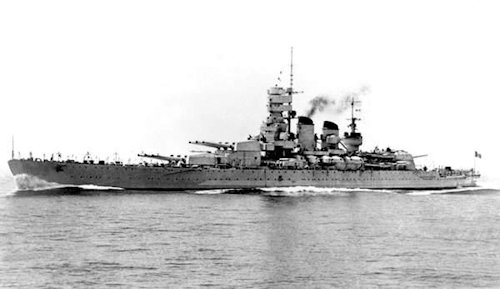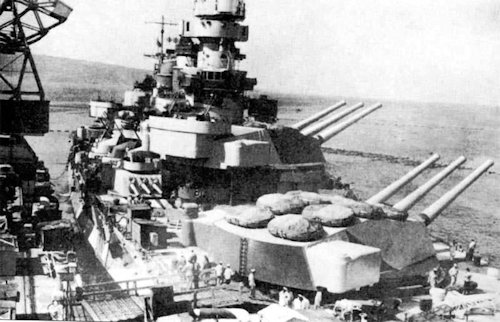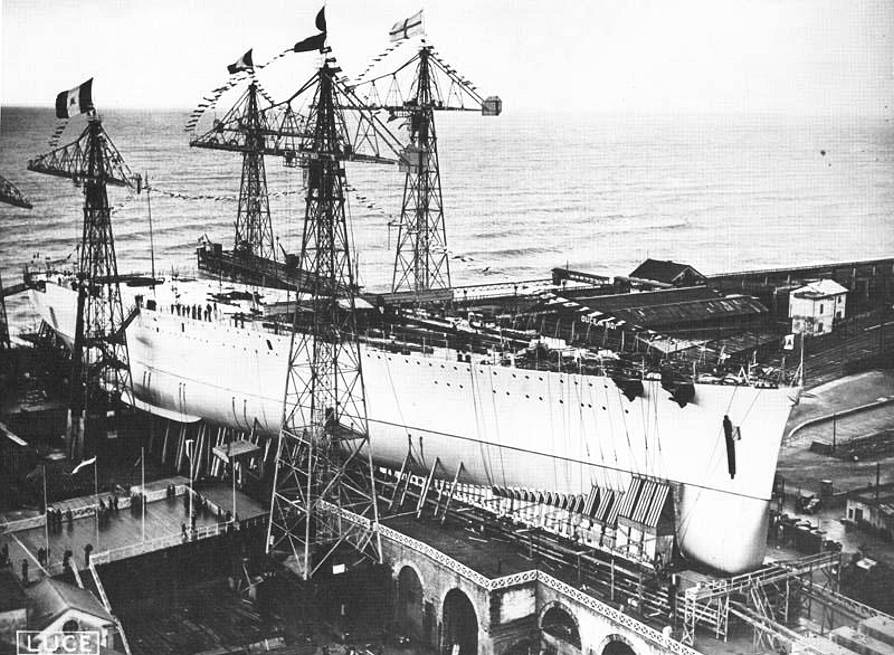The battleships of the class Littorio, set in the shipyards of Trieste and Genoa in the 1938, they were the first battleships from 35.000 tons built in the world and among the most successful Italian battleships for the balance of all their characteristics.
The 1922 Washington naval conference assigned to the Regia Marina a global displacement of 135.000 tons of battle ships, with the faculty to build - during the decade of "naval vacation" - units of this type for a total of 70.000 tons. However, the Royal Navy did not consider the immediate construction of new battleships for economic and political reasons. In the 1928, however, he thought it was time to solve the problem of his ships of the line, with regard to both the old units to be transformed and those to be built. For the former it was thought to reduce them to a minimum or even eliminate them. For the latter he began the study of a type of ship adapted to the alleged needs of the Italian naval policy. It was estimated to build at least three, to have two always able to operate. The preliminary design was then begun and divided into two distinct directives: one wanted ships from 23.000 tons armed with 6 pieces of 381 mm, in twin towers, with a speed of 28-29 knots; the other included 35.000 tons ships with 6 405 mm pieces, high protection and speed on the 29-30 knots.
 The day after the London Naval Conference of the 1930 (photo), in which the proposal to reduce the maximum displacement of the battleships from 35.000 to 25.000 tons was rejected, confirming the limits agreed in Washington, the first project that included ships was abandoned battle from 23.000 tons. The plans of the new battleships were therefore completely reworked.
The day after the London Naval Conference of the 1930 (photo), in which the proposal to reduce the maximum displacement of the battleships from 35.000 to 25.000 tons was rejected, confirming the limits agreed in Washington, the first project that included ships was abandoned battle from 23.000 tons. The plans of the new battleships were therefore completely reworked.
The final design of the inspector general of the Naval Engineers Umberto Pugliese (1880-1961) which included the construction of two units, was completed in the 1934. In October of the same year the two ships, ordered in the Ansaldo shipyards of Genoa Sestri and CRDA of Trieste, were set. With decree n. 1869 of the 10 October 1935, the new units were entered in the framework of the state military ship with the names of Vittorio Veneto e Littorio (photo opening). Meanwhile, the difficult political world situation and the failure of any attempt to limit armaments gave full freedom to the major powers and their Marines. The General Staff of the Regia Marina, estimating that two battleships from 35.000, even with the help of the old units remodeled, could not deal with any chance of success France and Great Britain allied in the Mediterranean, deemed it appropriate to further strengthen the battle team with others two units of the type Vittorio Veneto. Set in the 1938 in the CRDA shipyards of Trieste and Ansaldo of Genoa-Sestri, these two new units were named Roma e Empire, the latter was not completed due to the course of the conflict. Vittorio Veneto e Littorio, the first battleships from 35.000 tons built in the world, were certainly among the best-performing Italian ships for the balance of all their characteristics. In the 1940, at the time of their entry into service, they were like artillery among the most powerful battleships in the world and only in the 1942, with the entry of the Japanese supercoracasse calasse Yamato and American class Iowa, they lost this primacy. The battleships of the class Littorio were the culmination of the program fielded by Admiral Cavagnari (1876-1966) Chief of Staff of the Regia Marina between the 1933 and the 1940.
 Il Vittorio Veneto (photo) the 28 April 1940 entered service in Trieste, in the period 10 June 1940 - 8 September 1943 carried out 56 war missions. In the 1942 it was the first Italian battleship to be equipped with a radar system, an "EC4 Owl." It was the Italian battleship that carried out the greatest war activity. In the period of co-belligerency with the Allies the idea of using it in support for the landing in southern France and the Pacific, but political considerations led to the abandonment of these projects Vittorio Veneto it should have been given to Great Britain, but he gave it up, asking instead for the demolition of the unit. The 14 October 1947 the ship was transferred from Augusta to La Spezia where it disarmed the 3 January 1948, to then be demolished. The brass letters, which formed the name at the stern, are found at the Naval Museum of Venice.
Il Vittorio Veneto (photo) the 28 April 1940 entered service in Trieste, in the period 10 June 1940 - 8 September 1943 carried out 56 war missions. In the 1942 it was the first Italian battleship to be equipped with a radar system, an "EC4 Owl." It was the Italian battleship that carried out the greatest war activity. In the period of co-belligerency with the Allies the idea of using it in support for the landing in southern France and the Pacific, but political considerations led to the abandonment of these projects Vittorio Veneto it should have been given to Great Britain, but he gave it up, asking instead for the demolition of the unit. The 14 October 1947 the ship was transferred from Augusta to La Spezia where it disarmed the 3 January 1948, to then be demolished. The brass letters, which formed the name at the stern, are found at the Naval Museum of Venice.
Il Littorio the 20 May 1940 entered service in Genoa. After the events of 25 July 1943, the General Staff of the Regia Marina, with dispatch n. 31912 of the 30 July, ordered that it take the name of Italy. In 10 June 1940 - 8 September 1943 performed 46 war missions. In the period of co-belligerency with the Allies, as for the Vittorio Veneto, the possibility of its use in some theaters of war was discussed. According to the peace treaty theItaly it should have been handed over to the United States, but they gave it up and the battleship remained in possession of Italy. On June 1st 1948 was laid up and after a few months it was demolished in La Spezia.
Third unit, the battleship Roma (following photo), built and set up in Trieste and entered into service on 14 June 1942, it represented the best of Italian naval war production of the Second World War.

As we all know she was hit by two German radio-guided planing bombs "Ruhrstahl SD 1400 " in the waters of the Gulf of Asinara, at around 16.00 of the 9 September 1943. One bomb exploded at the starboard side and the other at the tower. The ship, due to the flooding of the premises, to the effects of the explosions of the ammunition depots and to the action of the fires that devastated it, after having considerably skidded, broke into a keel and sank divided into two sections. The loss of human lives was enormous. For administrative purposes the Roma was expelled from the framework of the military fleet by decree of the provisional Head of State of 18 October 1946. In his short service the Roma carried out 8 missions for transfer and 12 for exercises. The wreck was finally found the 28 June 2012 by a research team led by the engineer Guido Gay, with the presence of Navy personnel, in the Gulf of Asinara at 1.000 m depth and at about 16 miles from the Sardinian coast. It was thus possible to assign the correct position to what the Navy considers one of the most important "Shrines of the sea". Military personnel were able to confirm the accuracy of the wreck by comparing images of some anti-aircraft artillery guns. The writer, director and marine researcher Folco Quilici, in his novel "High Depth", reconstructed the phases of the sinking of the Roma inserting them in a search of the wreck, entrusted to two researchers, sponsored by a band of terrorists who aim to recover an explosive substance that would have been used in the rocket bomb that sank the ship.
Fourth unit of the class, theEmpire (photo below), launched the 15 November 1939 by the Ansaldo shipyard of Genoa-Sestri, it was never completed. On June 1st 1940 was towed from Genoa to Brindisi to avoid the danger of aerial bombardment from France, the 22 January 1942 reached Venice, then went on to Trieste where it was thought that construction could be completed. At the proclamation of the armistice, theEmpire it was abandoned by military personnel and fell into German hands. At the end of the war the unit was found half-sunk in the port of Trieste. Recovered, he was transferred to Venice and then demolished. He was struck down by decree of the 27 March 1947.
 (photo: web)
(photo: web)












